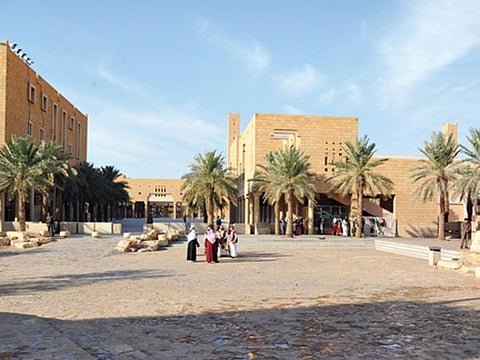Saudi Arabia’s Qasr Al Hokm parks — rendezvous with history
Unique blend of artistry, entertainment and history presents an irresistible attraction

Abu Dhabi: The Saudi capital of Riyadh boasts of many public parks that attract Saudi nationals as well as foreigners, not only because of their recreational facilities but also for their unique architectural designs and rich history.
Located at the centre of old Riyadh, Qasr Al Hokm Park retains the traditional architectural elements of old Riyadh in a modern setting.
The modern and traditional elements are reflected in the buildings around the park as well as by the verdant palm trees planted in symmetrical rows.
The cleanliness of the park, adorned with green palm trees, provides a welcome relief from the hot sun and offers a picture-perfect location.
Visitors soak up the beauty in the evening hours as the setting sun gradually envelops the park with its gold and orange hues.
Qasr Al Hokm Park, apart from its picturesque setting, also allows people an opportunity to revisit history. The unique blend of artistry, entertainment and history is an irresistible attraction to visitors.
Unifying the Arabian Peninsula
After King Abdullah Bin Abdul Aziz captured Riyadh in 1901, he built a palace on the site where his forefathers had ruled. For more than 30 years, this was his home and his headquarters, where he ran his military and political campaigns to conquer and unify the Arabian Peninsula. It remained the seat of national government until his death in 1953.
The palace is enormous, covering 11,500 square metres. When it was built, it was the largest structure in Riyadh, which was no more than a provincial town of adobe buildings surrounded by a wall. Rebuilt three times in the past century, the last of which was undertaken in the 1980s and overseen by the current king, King Salman Bin Abdul Aziz, who was then the governor, this palace is now home to the capital’s municipal government.
Qasr Al Hokm has been the seat of government since the mid-19th century. The name ‘Qasr Al Hokm’ means ‘Justice Palace’, and traditionally, justice was delivered in the main square there.
Traditional links
Directly opposite the palace is the Imam Turki Bin Abdullah Grand Mosque, which, at its capacity of 17,000, is the largest in the capital.
There are two covered passageways between the palace and the mosque. The bridge was first built after the assassination of Imam Bin Turki Bin Abdullah Al Saud in 1834.
When his father was killed, Imam Turki had the bridges constructed to allow him to safely walk to the mosque and pray. When King Abdul Aziz commissioned its reconstruction in 1909, he used the same concept.
The bridges also invoke the strong traditional links between the seat of government and the religion of Islam. This is a physical reminder of the alliance between Al Saud and the Al Sheikh, who have traditionally held many of the top religious posts in the country.
The bridge system also runs between the towers of the Qasr, allowing King Abdul Aziz to travel to his father’s house and visit the other members of his family housed in the four towers.
During the 1930s, the king built a new palace in the north of the city. It was so big that some travellers mistook it for the capital itself. The palace has now been partly converted into the King Abdulaziz Historical Center, which is also worth a visit.
The area around the Qasr Al Hokm makes for an interesting day out, allowing visitors to take a look at the Masmak citadel museum or the Souk Al Zal, where one can catch a glimpse of an old Riyadh, which is fast disappearing in the midst of rising skyscrapers.
Sign up for the Daily Briefing
Get the latest news and updates straight to your inbox






